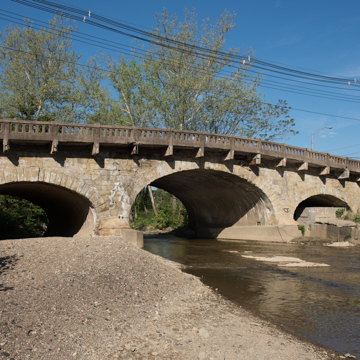Southeast of Highland Park, National Road passes under Interstate 70, traverses several blocks that constitute Elm Grove's commercial area, and then rises to cross Little Wheeling Creek on West Virginia's oldest stone bridge. Elm Grove, formerly an independent community at the end of the streetcar line seven miles from Wheeling, is now part of the city.
What appears as a typical mid-twentiethcentury concrete highway bridge, with walkways protected by balustraded concrete guardrails, is actually far, far older. Originally constructed in 1817 to carry the National Road over Little Wheeling Creek, it is a triple-arched bridge of uncoursed limestone. The central elliptical arch spans 38 feet; those to either end, 25 feet. In 1931 the original parapets were removed, and sidewalks and guardrails were added. In 1958 the bridge was sprayed with gunite. Moses Shepherd, who built all the bridges along the sixteen-mile course of the National Road through the Northern Panhandle, located this one so the road would pass close to his impressive stone mansion (see next entry), literally a stone's throw away. Henry Clay;














